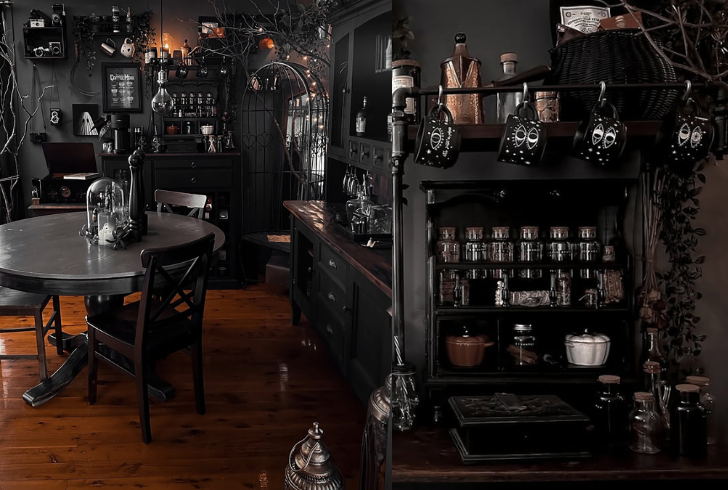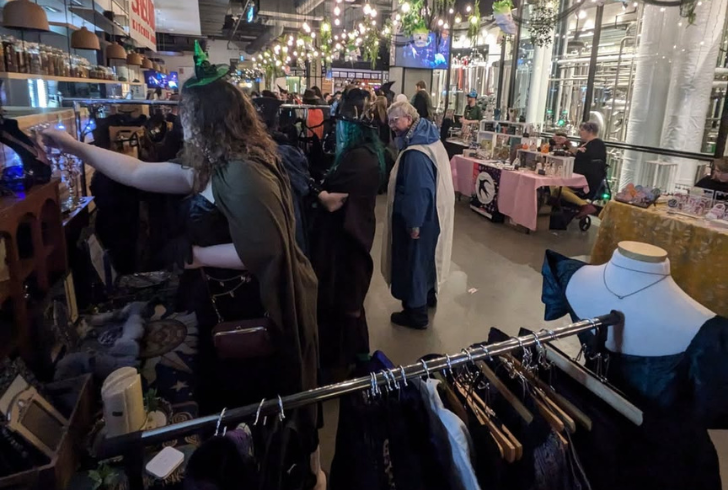Why Gothic and Spooky Shops Are Growing in Popularity
In recent years, a darkly stylish trend has emerged from the underground, blending horror culture with fashion and lifestyle. From eerie boutiques to horror-themed coffeehouses, a growing community is finding comfort in the macabre.
Across cities like Chicago, Los Angeles, and New York, gothic lifestyle shops are turning what was once a niche fascination into a mainstream aesthetic. The result is a culture where skulls, demons, and Victorian ghosts now share space with designer coffee and custom couture.
The Origins of Modern Horror Chic
The concept isn’t new. Back in the early 2000s, small horror shops like House of Monsters in Chicago’s Wicker Park quietly built a cult following. Its founder, Barry Kaufman, filled his second-floor store with latex vampire masks, imported Godzillas, and horror magazines stacked like sacred relics. For more than a decade, his shop served as a safe haven for horror fans, until it shut its physical doors in 2007 and moved online.
That move didn’t mark the end; it signaled a new beginning. Horror enthusiasts had found their community, and soon, other businesses began to catch on. According to Kaufman, “The horror community just needed a place to gather. It was always there; people just had to recognize it.”
Now, from coast to coast, horror-themed cafés, fashion stores, and restaurants have turned fear into flair. What was once confined to Halloween is now a year-round lifestyle.
Horror Becomes a Way of Life

Instagram | @southparksandiego | Horror lovers turn passion into everyday style as spooky stores thrive across cities.
Across America, businesses are embracing the aesthetic of the eerie. On Long Island, the Haunted House of Hamburgers welcomes guests with blood-red decor and spooky music. In Burbank, California, entire blocks are lined with horror shops. Even small towns have joined the movement, like Kissimmee, Florida’s Post Mortem Horror Boo-Tique, or the Famous Monster Pizza in Indiana.
This growing fascination is more than a passing fad. Horror now represents identity, nostalgia, and rebellion. For many, it’s a way to express individuality in a chaotic world. Interestingly, Illinois has become one of the leading hubs of the Gothic revival.
A Morning Brew With a Side of Horror
In Chicago’s Bridgeport neighborhood, Jackalope Coffee & Tea redefines what a café can be. Its walls are adorned with “Night of the Living Dead” posters, skull curtains, and murals of the “The Shining” twins reimagined as Día de los Muertos skeletons. A box labeled “Menstruatin’ With Satan” sits by the door, filled with free care items sponsored by the Satanic Temple of Illinois.
Co-owner January Overton explained that Jackalope’s atmosphere wasn’t built to shock; it was designed to celebrate alternative culture. “I wanted something that felt punk and fun,” she said. With punk classics like “Typical Girls” by The Slits playing in the background, it feels like stepping into a friendly haunt, where the macabre meets comfort.
Jackalope isn’t alone. Over in Avondale, The Brewed Coffeehouse draws horror lovers with its collection of movie memorabilia. Display cases feature treasures like a “Creature from the Black Lagoon” plate, a “Dark Shadows” board game, and tributes to films like “They Live” and “Get Out.” Even the name, The Brewed, nods to David Cronenberg’s cult classic “The Brood.”
When co-owner Jason Deuchler hosted a Halloween market, over a thousand guests attended. “We had an idea it might work,” he said, “but we didn’t expect people to love it this much.”
Where Witchcraft Meets Espresso
For those craving a softer take on gothic aesthetics, Edgewater’s Loaves + Witches offers a modern twist. Owned by practicing witches Lisa Harriman and Julia Goodmann, the café combines spiritual ambiance with elegant design. Its look is minimalist, black and white tones, natural textures, and soft lighting, but its soul is steeped in mysticism.
Goodmann shared, “Some people expected cauldrons and Disney-style witches, but our goal was to make it earthy, warm, and welcoming.” Their menu features creative names like Coven Cold Brew and Hex Your Ex Coffee Cake, adding a dash of humor to the witchy vibe.

Instagram | @the.grimm.remains | Witchcraft and coffee blend beautifully as gothic cafés turn dark charm into daily comfort.
Like many of Chicago’s gothic entrepreneurs, the pair sources their beans from Hexe Coffee, a horror-themed roastery in Lakeview. Its founder, Parker Slade, prints striking artwork on each bag; one features an eyeball impaled on a knife, another depicts demons bursting from a skull. While grocery chains found the designs “too intense,” customers loved them.
Hexe Coffee’s brick-and-mortar shop on Diversey Parkway has become a local weekend ritual. Lines spill out the door as regulars wait for their caffeine fix. Inside, the decor feels like equal parts art gallery and haunted parlor—skulls, antlers, and even a taxidermied tarantula line the moody, industrial space. “People call it cute,” Slade joked. “That’s when I swap the playlist from Steely Dan to Slayer.”
Shops That Celebrate the Strange
Goth culture doesn’t stop at coffee. In St. Charles, Ghoulish Mortals looks like it wandered off a Tim Burton set. Inflatable tentacles spill out of upper windows, while the “Haunted Mansion” soundtrack loops faintly inside. Shoppers browse eerie artwork, “Creature From the Black Lagoon” statues, and even a full-sized Audrey II from Little Shop of Horrors.
Owners Dove Thiselton and Warwick Price describe it as the place “where creepy meets creativity.” After seven years in business, their vision has turned into a profitable reality—proof that the gothic retail world can thrive on its own terms.
Nearby, The Horror House keeps its shelves stacked year-round with slasher merch—Friday the 13th tees, Pennywise fanny packs, and retro Halloween decor that fans refuse to pack away. Dracula puppets and Frankenstein dolls stare from the displays long after October ends.
In Bucktown, Graveface Records & Curiosities mixes horror memorabilia with racks of vinyl. It’s a cabinet of curiosities—cult film soundtracks beside taxidermied squirrels flipping the bird. Some pieces, like the Charles Manson enamel pins, toe the line, but they reflect the genre’s fascination with the forbidden and the absurd.
And for those drawn to books, Bucket O’ Blood Books & Records in Avondale is a shrine to horror and sci-fi. “We started because we couldn’t find small-press horror or marginalized voices,” co-owner Jennifer McKee explained. “It just grew naturally from there.”
Haunted Bars and Spooky Brews
Not all gothic spaces sell things—some pour pints. In Bloomingdale, Wolfden Brewing claims to be Illinois’s most haunted brewery. Set inside an 1851 building, it hosts ghost tours where staff swear they’ve seen flying plates and heard growling voices—sometimes right in the middle of trivia night.
Katie Wolf, who owns the brewery with her husband, said they didn’t believe the ghost stories at first. “Then things started happening, strange sounds, shadows moving,” she said. Yet, the spooky tales only added to the brewery’s popularity.
In Bridgeport, Overton and her husband extended their love of horror into nightlife with Electric Funeral, a bar draped in black walls, skeleton bartenders, and fog-breathing goat statues. Overton laughs about how mainstream visitors react: “We get normies who walk in like it’s a Rainforest Cafe.”
Up north in Kenosha, Wisconsin, the Final Girl bar merges local beer culture with slasher film nostalgia. Owner Chelsea Vecchione said the name pays tribute to horror’s ultimate survivor, the “final girl” trope. “It’s also about resilience,” she explained. “Being a queer woman in a male-dominated business, I relate to that survivor energy.”
Her bar’s menu includes cheeky items like Ripley’s Facehuggers wings and Pig’s Blood Korean BBQ sauce. Beneath murals of Jamie Lee Curtis and Michael Myers, guests sip craft beer under a neon sign that glows “Hello, Sidney”, a wink to “Scream.”
The Allure Behind the Darkness

Instagram | @ghoulboutique | Horror style steps boldly into mainstream fashion as dark design becomes everyday art.
What drives this obsession with the dark and uncanny? Experts believe it reflects a blend of nostalgia, rebellion, and creativity. The horror aesthetic enables people to explore taboo emotions, such as fear, mortality, and curiosity, in a controlled and often humorous manner.
Many fans find comfort in these spaces because they foster a sense of community. Horror fans who once felt isolated now have local hubs where they can share interests, support independent artists, and express themselves freely. The rise of social media has amplified that connection, allowing small gothic businesses to attract global audiences overnight.
From “The Exorcist” collectibles to haunted lattes, the gothic scene merges artistry and irony in ways few trends can match. And because it connects fashion, music, food, and literature, it appeals to people across generations.
Where Horror Culture Heads Next
As horror dominates pop culture with films like “Get Out,” “Hereditary,” and “M3GAN,” gothic lifestyle shops are moving from niche to mainstream. Once underground, they now influence home décor, fashion, and even luxury design, blending elegance with eerie charm.
Cities host thriving horror markets and gothic fairs, like Chicago’s Macabre Market, where visitors hunt for occult jewelry and monster art. Horror has evolved from entertainment into expression — a stylish and inclusive celebration of darkness.
From haunted coffeehouses to witchy bakeries and eerie boutiques, the gothic lifestyle turns the creepy into culture. In a world obsessed with the ordinary, horror remains beautifully bizarre — and fashionably alive.